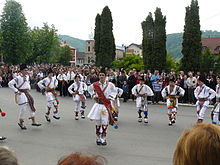Călușari
| Subclass of | fraternal organization |
|---|---|
| Country | Moldavia, Romania, Bulgaria, Macedonia |
| Country of origin | Romania |
| Intangible cultural heritage status | Representative List of the Intangible Cultural Heritage of Humanity, Masterpieces of the Oral and Intangible Heritage of Humanity |
| Described at URL | https://ich.unesco.org/en/RL/00090, https://ich.unesco.org/fr/RL/00090, https://ich.unesco.org/es/RL/00090 |

De Călușari (Romanian: Călușarii, Romanian pronunciation: [kəluˈʃarʲ]; Bulgarian: Калушари or Русалии; Macedonian: Русалии, singular: Călușar) be de members of sam fraternal secret society wey dey practice sam ritual acrobatic dance known as de căluș. Originally Romanian, de practice later spread go Bulgaria den North Macedonia. From three weeks afta Easter till Pentecost, wey dem dey bell am Rusalii for Romanian insyd, for around two weeks dem traditionally travel go all demma local communities wer dem go dance, wey few fiddlers accompany dem.[1]
History[edit | edit source]
No bro know de origins of de Călușari, although de first written attestations be from de 17th-century musical notations of Ioan Căianu.
Romanian historian of religion Mircea Eliade note say "Although dem dey make de oath for God ein name insyd, de mythico-ritual scenario wey calusari enact am no get nothing in common plus Christianity" wey, for 19th century insyd at least, na clerical opposition plus de group dey, plus ein members wey dem exclude dem say dem no go fi take communion for three years for sam regions insyd.[1]
Etymology[edit | edit source]
Na Mircea Eliade dey believe say de term Călușari originate plus de Romanian word for horse, cal, from de Latin caballus.[2]
References[edit | edit source]
- ↑ 1.0 1.1 Eliade (1975), p. 162.
- ↑ Eliade (1973), p. 115-122.

